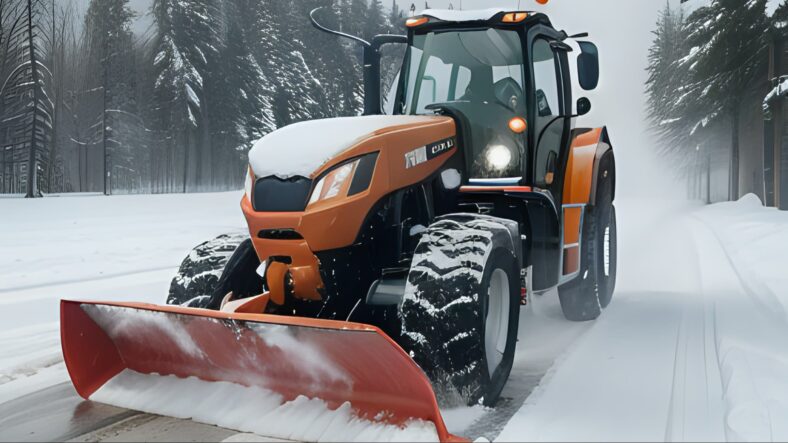For hospitals, emergency services, and other facilities that operate 24/7, maintaining access and business continuity is imperative. Effective snow management ensures unimpeded access across properties and avoids hazardous conditions that could lead to injuries or liability claims, which can increase snow removal costs.These critical community services cannot afford disruptions or impediments to their operations. As such, diligent and timely snow removal takes on heightened importance after winter storms. Proactive snow clearing is crucial for enabling emergency vehicles, personnel, patients, and visitors to safely enter these vital facilities at all hours. Reliable 24/7 snow removal is the key to providing hospitals, emergency services, and 24-hour businesses with the continuous accessibility they require for protecting the public and saving lives.
Why Snow Removal Matters for These Critical Services
Snow removal is essential for hospitals, emergency services, and other 24-hour operations in order to facilitate emergency vehicle access. Cleared roadways, entrances, parking lots, and walkways allow ambulances and fire trucks to rapidly reach those in need and transport patients to care. Snow clearing also lets staff access facilities safely to provide vital community healthcare and emergency response services without interruption. Patients and visitors must be able to enter and exit medical centers safely as well. Diligent snow removal reduces the risk of slip and falls injuries occurring on hospital and emergency service premises. Additionally, properly cleared pavements are necessary for meeting regulatory codes as well as accreditation requirements related to accessibility, safety, and hazard mitigation. Maintaining passageways free of snow and ice should be a top priority for these institutions to uphold their paramount mission of serving the public’s health, safety, and well-being at all times.
Unique Challenges and Considerations
Snow removal for hospitals, emergency services, and other 24-hour operations comes with unique challenges due to their constant operations. As these facilities remain open overnight and 24/7, maintaining clearance of roadways and walkways is essential at all hours, despite lighter traffic at night. Tight access points such as emergency department entrances often require meticulous snow clearing as well. The small margin for error and high liability associated with poor conditions leading to injury results in intensive resource demands for clearing and maintaining vast medical and emergency response properties. With staff, patients, and visitors entering facilities at all times, there are greater risks if snow and ice hazards exist. Additionally, the complexity of large campuses makes snow management highly labor-intensive. Meeting the imperative for diligent around-the-clock snow removal requires facing these considerable obstacles.
Developing an Effective Snow Removal Plan
An effective snow removal plan is essential for 24/7 facilities to maintain access and safety. Critical access points such as emergency and patient entrances should be identified, along with high-traffic areas. A prioritized clearing plan can then be created, establishing routes and locations that will be addressed first after snowfall. Ongoing communication protocols must also be implemented to coordinate efforts and convey updates. Determining necessary equipment and staffing needs based on the property’s size and features allows snow removal resources to be adequately allocated while controlling costs. With diligent 24/7 monitoring and rapid mobilization when snow accumulates, clearance can begin immediately. Strategically stocking and placing de-icers improves efficiency. For in-house teams or contractors tasked with snow removal, proper training is key. Additionally, clarifying roles and responsibilities ensures accountability across snow management operations. With a comprehensive plan covering these key elements, 24-hour facilities can execute snow clearing in an organized, efficient manner despite challenging circumstances.
Best Practices for 24-Hour Snow Removal
Maintaining reliable 24/7 access through snow requires utilizing key best practices. Having a plow and salt truck on-site or positioned nearby allows for rapid response when snow accumulates. Weather tracking technology gives advance notice to mobilize crews. Providing personnel with detailed property maps and info helps streamline operations. On-demand snow-melting equipment can supplement plowing in problematic areas. Strategically placing emergency snow removal supplies around the premises improves efficiency. Monitoring high-risk zones in real time enables prompt attention when issues arise. Coordinating with local authorities can facilitate the clearing of adjacent roadways and coordinated access. With diligent implementation of these measures, 24-hour facilities can execute prompt, effective snow removal despite tight timeframes. Adopting proven snow management strategies allows hospitals, emergency services, and other critical operations to maintain safe access around the clock.
The Importance of the Right Snow Partner
Selecting the right partner is critical for 24/7 snow removal needs. Vet providers thoroughly on round-the-clock reliability and sufficient capacity. Look for flexibility, responsiveness, and proven experience with similar large properties. The provider should have strong supervision and training for crews, like Earth Development implements. Established contingency plans for extreme storms are key as well. A proven safety record removes liability concerns over slips and falls. With stringent vetting, 24/7 facilities can find an ideal snow removal partner to meet their unique needs, even during the toughest winter conditions. Choosing the right fit ensures maintaining safe access and operations.
Conclusion
Snow removal for 24/7 critical services carries increased liability yet remains essential to maintain operations and safety. It requires strategic planning and diligent 24/7 execution. Partnering with a qualified, dedicated snow provider optimizes clearance while controlling costs. Following snow management best practices tailored to these unique properties reduces risks and provides peace of mind that access will be maintained. Overall, proper snow and ice management must be a priority for hospitals, emergency services, and other around-the-clock operations to fulfill their vital mission of serving communities without interruption.
